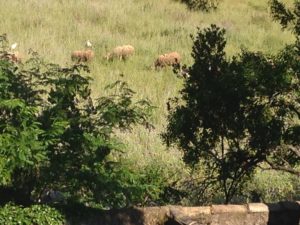What we do not know about the natural world around us is an extensive body of information. Quite.
In the past decade, for the first time in human history more people live in urban than in rural areas, according to the UN.
And we City Kids often don’t know what to make of our surroundings when we move to a rural zone after, oh, a half century spent in built-up areas where a vacant lot is considered “nature”.
Like in the field behind where we live, in this lightly populated corner of southern France.
If we didn’t know better, we would insist that some white birds with long legs are flying around the local herd of sheep and goats … and sitting on the backs of those mammals.
Oh, wait. That is exactly what they are doing.
And now we know why.
For many instances of rural activities, we depend on our neighbor, who spent much of her youth in the farmlands of England and is a walking encyclopedia on flora and fauna.
She said, yes, she had seen the egrets (Oh, that’s what they are!) perched atop the sheep as the woolly boys go about their business of cropping the square mile or so of grazing land behind our place.
At first, I watched the white birds circling above the herd but thought it was very possible they were landing near the sheep. Not on them.
So, I fetched the binoculars and had a long look.
Some of the birds were landing on the ground but, yes, some were landing on the sheep — who didn’t seem to mind at all!
It turns out, the birds are known as cattle egrets — and they have become one of the most successful species of bird, over the past two or three centuries; they now are found on every continent aside from Antarctica.
It works like this: From their natural home ground in the Iberian peninsula, which is just an hour south from where we live, cattle egrets have spread around the world thanks to humans developing herds of animals in more and more parts of the world.
The cattle egrets apparently are most often seen hanging around … cattle … (hence the name), but they will hitch a ride (see photo, upper-left, above) with other mammals big enough not to be fussed by a one-pound bird landing on their backs.
The egrets follow around the herd animals looking for something to eat after the bigger animals have churned up the ground, perhaps exposing worms or grubs.
When the hunt on the ground goes cold, the egrets take off, circle, pick out a sheep and take a seat. They sometimes pick out insects they see on the backs of their rides, and snap those up. Ticks, in particular.
Thus, it is a symbiotic relationship. Humans, herd animals, egrets.
Cattle egrets, unlike most of their egret kin, have pretty much given up a life in the water. Sitting on cows and sheep seems to work out better, and they have followed the herds to Asia and Africa and Australia and New Zealand and to the Americas, too.
Most city folk have not noticed because in the urban world you just don’t see 100-member herds of mammals feeding on the range.
In the sticks, however, we see these things and wonder about them and sometimes we figure out what we are looking at.
We aspire to become hayseeds. We have a long way to go.


0 responses so far ↓
There are no comments yet...Kick things off by filling out the form below.
Leave a Comment